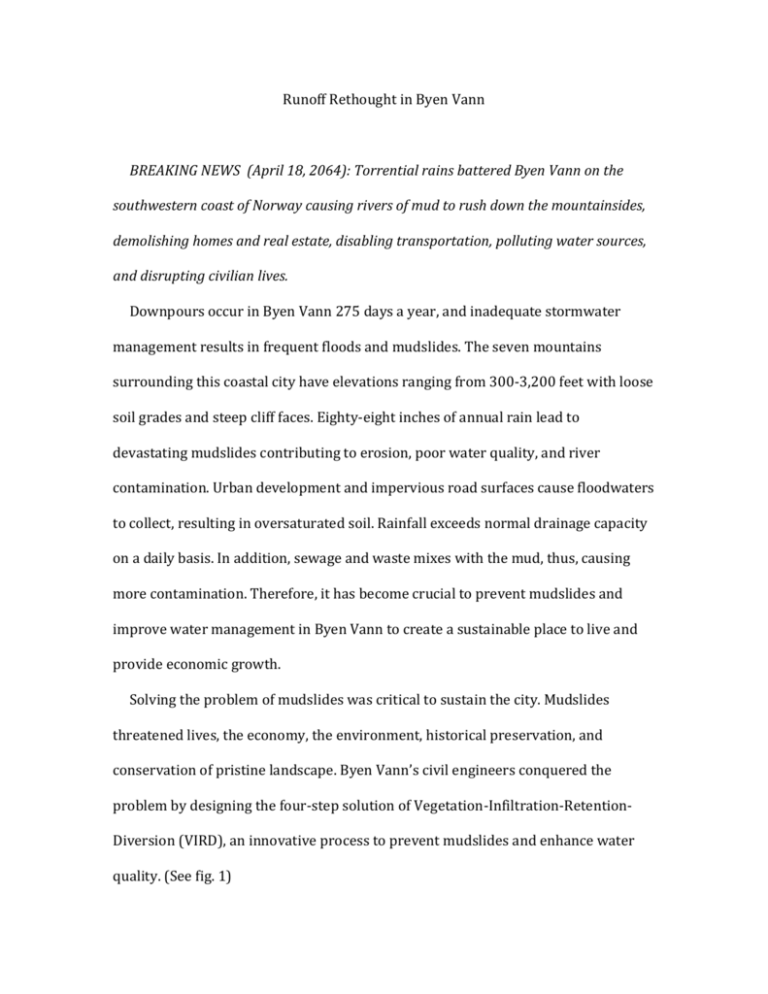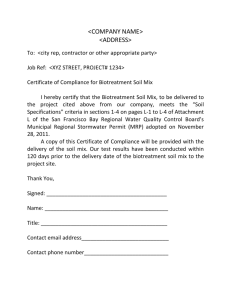Byen Vann - Future City Competition
advertisement

Runoff Rethought in Byen Vann BREAKING NEWS (April 18, 2064): Torrential rains battered Byen Vann on the southwestern coast of Norway causing rivers of mud to rush down the mountainsides, demolishing homes and real estate, disabling transportation, polluting water sources, and disrupting civilian lives. Downpours occur in Byen Vann 275 days a year, and inadequate stormwater management results in frequent floods and mudslides. The seven mountains surrounding this coastal city have elevations ranging from 300-3,200 feet with loose soil grades and steep cliff faces. Eighty-eight inches of annual rain lead to devastating mudslides contributing to erosion, poor water quality, and river contamination. Urban development and impervious road surfaces cause floodwaters to collect, resulting in oversaturated soil. Rainfall exceeds normal drainage capacity on a daily basis. In addition, sewage and waste mixes with the mud, thus, causing more contamination. Therefore, it has become crucial to prevent mudslides and improve water management in Byen Vann to create a sustainable place to live and provide economic growth. Solving the problem of mudslides was critical to sustain the city. Mudslides threatened lives, the economy, the environment, historical preservation, and conservation of pristine landscape. Byen Vann’s civil engineers conquered the problem by designing the four-step solution of Vegetation-Infiltration-RetentionDiversion (VIRD), an innovative process to prevent mudslides and enhance water quality. (See fig. 1) Figure 1- Segment of VIRD System The first step, vegetation, consists of introducing rush plants and hardy bog plants in mudslide-prone areas for bio-retention. The strong root systems reinforce the unconsolidated soil matrix. Moisture probes in the soil measure saturation rates of the soil. An array of weather stations provides representative readings of the precipitation conditions of the entire area. The next lines of defense are infiltration and retention. Strategically placed retention walls create temporary revetment pools that collect water and allow infiltration. Excess water collects until it reaches a height of three feet and then moves into the overflow. Next, the water drains into raised boreholes and travels to below ground storage of abandoned limestone mineshafts. To increase water infiltration, the engineering team injects liquid carbon nano-tubes, which form around imperfections in the soil to minimize the change to the soil’s grade. Once in the mineshafts, the water is filtered and detained until needed. Through horizontal boreholes, it is transported into the city. Diversion, the last step, directs overflow towards the river and into a mile-long pond site. A multitude of technologies, including advanced bio-retention and diversion, are needed in order for the system to function. Carbon nanotubes, allotropes of carbon in a steroidal nano configuration, are injected into moist soil to break surface tension and increase drainage. Next, advanced retention technologies are employed, together with boreholes. Retention methods include flagstone retaining walls that have a weir in the top lip for drainage to the next wall if the boreholes become inundated. Finally, basic diversion technologies such as dams and drainage channels, together with an off-site diversion pond, are implemented. The pond, a modified version of a rain garden, is filled with stones and retentive water plants. In order to utilize the water for drinking and bathing and increase sustainability, the water sanitation engineers developed nano-sponges that absorb viruses and chemicals from the mine water. While 75% of the sterilized water is siphoned and distributed, one-quarter is left in reserve. Community outreach and buy-in are critical to VIRD’s implementation; therefore, Public Service Announcements (PSAs), digital newsflashes, and social media advisories are distributed to residents, businesses, and builders. Trained spokespeople and programs supplement the media campaign in community centers and schools. Financial assistance and recognition programs for execution of storm water Best Management Practices (BMPs) such as use of pervious surfaces, green roofs, and eco-friendly drainage systems encourage compliance. Increasing sustainability, VIRD’s environmental benefits include the dramatic improvement of water quality, reduction of run-off, and increased infiltration. In the past, mudslides would consume land, destroy infrastructure, clog waterways, and kill residents and wildlife. One potential risk is the failure of the highly complex Super-SCADA control system, which relies on computers to operate all components of VIRD. Communication or power losses could compromise the system’s functionality, ultimately leading to soil saturation and causing mudslides. The system is designed to handle a 100-year peak rainfall; therefore, a storm of greater intensity could overwhelm the system. The water would then be diverted to emergency holding ponds. If this were to occur, an evacuation alarm would be sent to residents via communication bracelets and social media advisories. To prevent this, geotechnical, hydrologic, and mechanical engineers created redundancies with manually operated gravity overflows. The geotechnical engineers assess soil properties, testing soil stability and assessing chemical properties of the soil along with risks of certain slopes. Additionally, they design the retaining walls making certain that structures are stable under soil conducts. Hydrologic engineers control the flow of water as well as focus on water supply, distribution, treatment and conservation. Mechanical engineers oversee the manufacturing of the mechanical components, computers, and hardware. Although engineers solved the critical problem, some trade offs were inevitable. The initial investment for installation and labor costs to maintain VIRD is high, but the payback is realized by maintaining an uninterrupted economy. Implementation of retention technologies leaves scars on the topography and plant life of the mountainsides. Eco-engineers devised a five-year creative plan to restore habitat balance to its original state. The benefits of this solution to the community far outweigh the limited tradeoffs. The engineers of Byen Vann vanquished the century old problem of mudslides by efficiently managing stormwater run-off with the VIRD system. This sophisticated computer-based technology provides a safe and stable environment, sustainable economy, and quality of life in Byen Vann. (941 words) Works Cited Cedergren, Harry R. Seepage, Drainage, and Flow Nets. New York: Wiley, 1989. Print. Das, Braja M. Principles of Geotechnical Engineering. 2nd edition, Vol. 1. Print. "Engineering Geologist: Job Description." | Prospects.ac.uk. Web. 23 Nov. 2012. <http://www.prospects.ac.uk/engineering_geologist_job_description.htm>. "EPA - Stormwater Menu of BMPs." EPA - Stormwater Menu of BMPs, Web. 19 Oct. 2012. <http://cfpub.epa.gov/npdes/stormwater/menuofbmps/index.cfm?action=factsheet _results>. "History of Bergen." History of Bergen, Dec. 2012. Web. 14 Dec. 2012. "How Nanotech Can Meet the Poor's Water Needs." SciDevNet Global. 27 Nov. 2012. Web. 16 Nov. 2012. <http://www.scidev.net/en/newtechnologies/nanotechnology-for-clean-water/editorials/how-nanotech-can-meetthe-poor-s-water-needs.html>. "Method and Apparatus for Preventing Mud Slides - Elliott, Curtis." Method and Apparatus for Preventing Mud Slides - Elliott, Curtis. Web. 26 Nov. 2012. <http://www.freepatentsonline.com/4671701.html>. "Method and Apparatus for Preventing Mud Slides - Elliott, Curtis." Method and Apparatus for Preventing Mud Slides - Elliott, Curtis. Web. 26 Nov. 2012. <http://www.freepatentsonline.com/4671701.html>. "Minerals of Norway." Minerals of Norway. Web. 26 Nov. 2012. <http://worldgeography.org/norway/771-minerals-of-norway.html>. "Nanosponges: South Africa's High Hopes for Clean Water." SciDevNet Global. 27 Nov. 2012. Web. 8 Nov. 2012. <http://www.scidev.net/en/features/nanosponges-southafrica-s-high-hopes-for-clean-wa.html>. "Norway - Climate Adaptation." Norway - Climate Adaptation. Web. 4 Dec. 2012. "A Quick Guide to Norway." H2g2 -. Web. 9 Dec. 2012. "Rain Garden Plants." Rain Garden Plants. Web. 01 Dec. 2012. <http://www.rainscaping.org/index.cfm/fuseaction/plants.main/typeID/37/index.h tm>. "SCADAÂ Explained." SCADAÂ Explained. Web. 10 Dec. 2012. "VH400 Soil Moisture Sensor." VH400 Soil Moisture Sensor. Web. 13 Dec. 2012. Wanielista, Martin P. Hydrology and Water Quantity Control. New York: Wiley, 1990.







